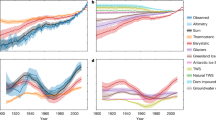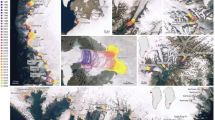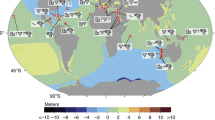Abstract
Recent estimates of Antarctica’s present-day rate of ice-mass contribution to changes in sea level range from 31 gigatonnes a year (Gt yr−1; ref. 1) to 246 Gt yr−1 (ref. 2), a range that cannot be reconciled within formal errors3. Time-varying rates of mass loss2,4,5,6 contribute to this, but substantial technique-specific systematic errors also exist3. In particular, estimates of secular ice-mass change derived from Gravity Recovery and Climate Experiment (GRACE) satellite data are dominated by significant uncertainty in the accuracy of models of mass change due to glacial isostatic adjustment7,8 (GIA). Here we adopt a new model of GIA, developed from geological constraints, which produces GIA rates systematically lower than those of previous models, and an improved fit to independent uplift data9. After applying the model to 99 months (from August 2002 to December 2010) of GRACE data, we estimate a continent-wide ice-mass change of −69 ± 18 Gt yr−1 (+0.19 ± 0.05 mm yr−1 sea-level equivalent). This is about a third to a half of the most recently published GRACE estimates2,5, which cover a similar time period but are based on older GIA models. Plausible GIA model uncertainties, and errors relating to removing longitudinal GRACE artefacts (‘destriping’), confine our estimate to the range −126 Gt yr−1 to −29 Gt yr−1 (0.08–0.35 mm yr−1 sea-level equivalent). We resolve 26 independent drainage basins and find that Antarctic mass loss, and its acceleration, is concentrated in basins along the Amundsen Sea coast. Outside this region, we find that West Antarctica is nearly in balance and that East Antarctica is gaining substantial mass.
This is a preview of subscription content, access via your institution
Access options
Subscribe to this journal
Receive 51 print issues and online access
$199.00 per year
only $3.90 per issue
Buy this article
- Purchase on Springer Link
- Instant access to full article PDF
Prices may be subject to local taxes which are calculated during checkout


Similar content being viewed by others
References
Zwally, H. & Giovinetto, M. B. Overview and assessment of Antarctic ice-sheet mass balance estimates: 1992–2009. Surv. Geophys. 32, 351–376 (2011)
Velicogna, I. Increasing rates of ice mass loss from the Greenland and Antarctic ice sheets revealed by GRACE. Geophys. Res. Lett. 36, L19503 (2009)
Shepherd, A. & Wingham, D. Recent sea-level contributions of the Antarctic and Greenland ice sheets. Science 315, 1529–1532 (2007)
Rignot, E., Velicogna, I., van den Broeke, M. R., Monaghan, A. & Lenaerts, J. Acceleration of the contribution of the Greenland and Antarctic ice sheets to sea level rise. Geophys. Res. Lett. 38, L05503 (2011)
Chen, J. L., Wilson, C. R., Blankenship, D. & Tapley, B. D. Accelerated Antarctic ice loss from satellite gravity measurements. Nature Geosci. 2, 859–862 (2009)
Wingham, D. J., Wallis, D. W. & Shepherd, A. Spatial and temporal evolution of Pine Island Glacier thinning, 1995–2006. Geophys. Res. Lett. 36, L17501 (2009)
Barletta, V. R., Sabadini, R. & Bordoni, A. Isolating the PGR signal in the GRACE data: impact on mass balance estimates in Antarctica and Greenland. Geophys. J. Int. 172, 18–30 (2008)
Velicogna, I. & Wahr, J. Measurements of time-variable gravity show mass loss in Antarctica. Science 311, 1754–1756 (2006)
Whitehouse, P. L., Bentley, M. J. & Le Brocq, A. M. A deglacial model for Antarctica: geological constraints and glaciological modelling as a basis for a new model of Antarctic glacial isostatic adjustment. Quat. Sci. Rev. 32, 1–24 (2012)
Solomon, S., et al., eds. Contribution of Working Group I to the Fourth Assessment Report of the Intergovernmental Panel on Climate Change (Cambridge University Press, 2007)
Tamisiea, M. E., Mitrovica, J. X., Milne, G. A. & Davis, J. L. Global geoid and sea level changes due to present-day ice mass fluctuations. J. Geophys. Res. 106, 30849–30863 (2001)
Stammer, D., Agarwal, N., Herrmann, P., Kohl, A. & Mechoso, C. R. Response of a coupled ocean-atmosphere model to Greenland ice melting. Surv. Geophys. 32, 621–642 (2011)
Bentley, M. J. et al. Deglacial history of the West Antarctic Ice Sheet in the Weddell Sea embayment: constraints on past ice volume change. Geology 38, 411–414 (2010)
Thomas, I. D. et al. Widespread low rates of Antarctic glacial isostatic adjustment revealed by GPS observations. Geophys. Res. Lett. 38, L22302 (2011)
Bevis, M. et al. Geodetic measurements of vertical crustal velocity in West Antarctica and the implications for ice mass balance. Geochem. Geophys. Geosyst. 10, Q10005 (2009)
Mackintosh, A. et al. Retreat of the East Antarctic ice sheet during the last glacial termination. Nature Geosci. 4, 195–202 (2011)
Whitehouse, P. L., Bentley, M. J., Milne, G. A., King, M. A. & Thomas, I. D. A new glacial isostatic adjustment model for Antarctica: calibrated and tested using observations of relative sea-level change and present-day uplift rates. Geophys. J. Int. 190, 1464–1482 (2012)
Ivins, E. R. & James, T. S. Antarctic glacial isostatic adjustment: a new assessment. Antarct. Sci. 17, 541–553 (2005)
Peltier, W. R. Global glacial isostasy and the surface of the ice-age Earth: the ICE-5G (VM2) model and GRACE. Annu. Rev. Earth Planet. Sci. 32, 111–149 (2004)
Tregoning, P., Ramillien, G., McQueen, H. & Zwartz, D. Glacial isostatic adjustment and nonstationary signals observed by GRACE. J. Geophys. Res. 114, B06406 (2009)
Horwath, M. & Dietrich, R. Signal and error in mass change inferences from GRACE: the case of Antarctica. Geophys. J. Int. 177, 849–864 (2009)
Wouters, B., Chambers, D. & Schrama, E. J. O. GRACE observes small-scale mass loss in Greenland. Geophys. Res. Lett. 35, L20501 (2008)
Pritchard, H. D. et al. Antarctic ice-sheet loss driven by basal melting of ice shelves. Nature 484, 502–505 (2012)
Rignot, E. et al. Recent Antarctic ice mass loss from radar interferometry and regional climate modelling. Nature Geosci. 1, 106–110 (2008)
Davis, C. H., Li, Y., McConnell, J. R., Frey, M. M. & Hanna, E. Snowfall-driven growth in East Antarctic Ice Sheet mitigates recent sea-level rise. Science 308, 1898–1901 (2005)
Gunter, B. et al. A comparison of coincident GRACE and ICESat data over Antarctica. J. Geodesy 83, 1051–1060 (2009)
Church, J. A. & White, N. J. Sea-level rise from the late 19th to the early 21st century. Surv. Geophys. 32, 585–602 (2011)
Church, J. A. et al. Revisiting the Earth’s sea-level and energy budgets from 1961 to 2008. Geophys. Res. Lett. 38, L18601 (2011)
Jacob, T., Wahr, J., Pfeffer, W. T. & Swenson, S. Recent contributions of glaciers and ice caps to sea level rise. Nature 482, 514–518 (2012)
Gladstone, R. M. et al. Calibrated prediction of Pine Island Glacier retreat during the 21st and 22nd centuries with a coupled flowline model. Earth Planet. Sci. Lett. 333–334, 191–199 (2012)
Cheng, M. K. & Tapley, B. D. Variations in the Earth’s oblateness during the past 28 years. J. Geophys. Res. 109, B09402 (2004)
Tamisiea, M. E. Ongoing glacial isostatic contributions to observations of sea level change. Geophys. J. Int. 186, 1036–1044 (2011)
Swenson, S., Chambers, D. & Wahr, J. Estimating geocenter variations from a combination of GRACE and ocean model output. J. Geophys. Res. 113, B08410 (2008)
Rodell, M. et al. The global land data assimilation system. Bull. Am. Meteorol. Soc. 85, 381–394 (2004)
Wahr, J., Molenaar, M. & Bryan, F. Time variability of the Earth’s gravity field: hydrological and oceanic effects and their possible detection using GRACE. J. Geophys. Res. 103, 30205–30229 (1998)
Purcell, A. et al. Relationship between glacial isostatic adjustment and gravity perturbations observed by GRACE. Geophys. Res. Lett. 38, L18305 (2011)
Swenson, S. & Wahr, J. Post-processing removal of correlated errors in GRACE data. Geophys. Res. Lett. 33, L08402 (2006)
Acknowledgements
This work was funded by NERC, and an RCUK Academic Fellowship to M.A.K., and partially supported by COST Action ES0701. G.A.M. acknowledges support from the Natural Sciences and Engineering Research Council of Canada and the Canada Research Chairs programme. We thank E. Ivins for discussions.
Author information
Authors and Affiliations
Contributions
M.A.K. and G.A.M. conceived the study. M.A.K. oversaw the work and wrote the paper. P.M. did the GRACE processing and R.J.B. did the forward modelling. R.J.B. and M.A.K. did the leakage analysis. P.L.W., M.J.B. and G.A.M. developed the GIA model. All authors commented on the paper.
Corresponding author
Ethics declarations
Competing interests
The authors declare no competing financial interests.
Supplementary information
Supplementary Information
This file contains Supplementary Text 1-5, which includes Supplementary Figures 1-4, Supplementary Tables 1-2 and Supplementary References. (PDF 1007 kb)
PowerPoint slides
Rights and permissions
About this article
Cite this article
King, M., Bingham, R., Moore, P. et al. Lower satellite-gravimetry estimates of Antarctic sea-level contribution. Nature 491, 586–589 (2012). https://doi.org/10.1038/nature11621
Received:
Accepted:
Published:
Issue Date:
DOI: https://doi.org/10.1038/nature11621
This article is cited by
-
Climate variability a key driver of recent Antarctic ice-mass change
Nature Geoscience (2023)
-
Atmospheric River Signatures in Radiosonde Profiles and Reanalyses at the Dronning Maud Land Coast, East Antarctica
Advances in Atmospheric Sciences (2020)
-
Reducing filter effects in GRACE-derived polar motion excitations
Earth, Planets and Space (2019)
-
Global environmental consequences of twenty-first-century ice-sheet melt
Nature (2019)
-
Solid Earth change and the evolution of the Antarctic Ice Sheet
Nature Communications (2019)
Comments
By submitting a comment you agree to abide by our Terms and Community Guidelines. If you find something abusive or that does not comply with our terms or guidelines please flag it as inappropriate.



